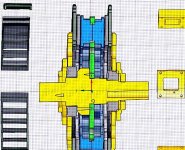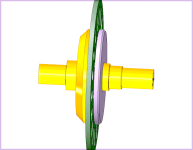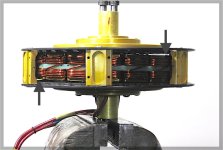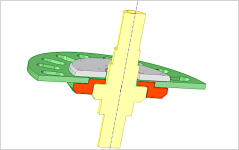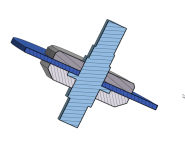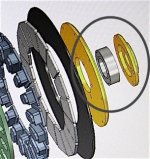The stator plate is flat, and it is bending, unfortunately. But it doesn't appear to want to bend any further. The rotors
are moving the rest of the way.
I would think that there would be an equilibrium too, and I'm thinking it will be more so during operation, when the
steel cores become opposing magnets, and not just steel.
I did use spacers during assembly, (popsicle sticks), but as soon as you pull them out,.. it snaps over. A sound I've grown
to hate!
I used to think that being able to adjust the air gap in an axial motor was a great feature, but now I'm thinking it's a
almost a curse. If theres any slop in the bearings, caps, or rotors, then there will be trouble. And the stator carrier has
to be very strong. Lessons learned.
I've got my fingers crossed, hoping that it's not the two piece rotors that are adding to the problem as well. But I think
that if it is, then I can re-assemble them with glue. Hind sight is 20/20, as the saying goes.
I don't think the photo can be used that way Dui, ni shuo de dui, although it certainly looks that way. Your combination
option looks pretty good though, and I hadn't thought of that. Theres not much room behind there, but there might be
enough. I'll have to draw it up and see how things fit. Good job.:thumb:
I can't make the washer thicker on top because of the wiring, unfortunately, I wish I could, but things are pretty tight on
that side.
I looked up carbon fiber plate, and see that 5mm is the common thickness. If I bond some .020" fiberglass to each side,
then it would make the thickness I need, and insulate the other parts, as well as strengthen the slot cuts. Cost...$50.
Carbon fiber is subject to eddy currents, but less than aluminum, (I think), and I was using aluminum on the last motor,
and I was using two plates. The motor ran fine, and didn't get all that hot, but I don't know how much of the heat was
aluminum related.
If it comes down to it, I could make the carrier out of 'all aluminum' again,.. cut and bond the slots, and make it thicker
where needed. One piece. It would be cheaper, and at least get things moving again. Just a thought.



